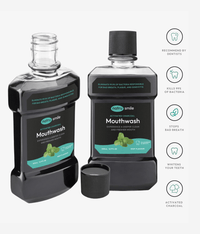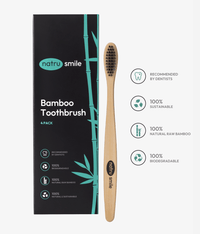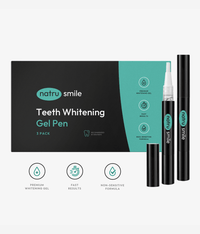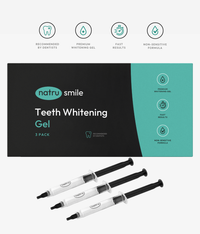
All products are certified by dental expert Dr. Greg Grillo
Congratulations! You've made it through your orthodontic journey and are ready to embark on the next phase of flaunting a perfect smile. As braces removal day approaches, it's natural to feel a mix of excitement and curiosity about what will happen on this momentous occasion. To help ease your concerns and give you a better idea of what to expect, we've put together a detailed guide covering every aspect of the braces removal process. In this guide, we'll address any questions or concerns you might have, ensuring that you're well-prepared for this significant day.
How Long Does It Take To Get Braces Off: An In-Depth Overview
The process of removing braces varies depending on several factors, which include the complexity of your dental case, the type of braces you were using throughout the treatment, and the skill level of your orthodontist. In this detailed overview, we'll discuss these factors and provide a general time frame for how long it might take to have your braces removed and your teeth cleaned thoroughly.
Signs Your Braces Are Coming Off Soon
Orthodontic treatment, such as braces, typically includes an informed timeline for the duration of the treatment to align your teeth properly. It's a fantastic feeling when your braces are ready to come off, and you can show off your new and improved smile. If you've been diligently monitoring the progression of your orthodontic treatment and have started to notice significant improvements in your teeth and bite, you might be close to the end of your treatment plan, and it's time to think about removing your braces. Below, we've compiled a list of common indicators that suggest your braces could be coming off soon.
Well-Aligned Teeth And Corrected Bite Problems
One of the primary goals of orthodontic treatment is to straighten your teeth and ensure proper bite alignment. If the appearance of your teeth has vastly improved and any previous bite issues (such as an overbite or underbite) have been resolved, this could be a sign that your braces have achieved their purpose and are ready to come off.
Closed Gaps And Resolved Overcrowding Issues
Another common dental issue that braces address is correcting gaps and overcrowding in your teeth. Gaps between teeth affect your smile aesthetics, while overcrowding creates problems with cleaning and periodontal health. If you notice that the gaps in your teeth have closed and previous overcrowding issues have been resolved, these are positive signs that you're approaching the end of your orthodontic treatment.
Orthodontist Provides An Upcoming Removal Date During A Routine Appointment
Of course, one of the definitive signs that your braces are coming off soon is when your orthodontist informs you during a routine check-up appointment. They will have monitored your treatment progress and deemed your teeth sufficiently aligned, warranting the removal of your braces. At this point, your orthodontist may provide you with a specific date or time frame for the removal of your braces.
Overall, it's essential to remember that your orthodontist is your best source of information regarding your braces removal timeline. Even if you notice these signs, always consult with your orthodontist to confirm that it's time for your braces to be removed.
Preparing For The Removal Of Braces: Essential Steps To Take
Brace removal is an exciting moment as it marks the completion of your orthodontic treatment. To ensure a smooth transition and maintain the results achieved, it's crucial to follow some essential steps before getting your braces off:
1. Schedule A Dental Cleaning Appointment
Ideally, you should book an appointment with your dentist for a thorough dental cleaning and checkup shortly after your braces are removed. This ensures that any food particles, plaque buildup, or tartar that might have accumulated during your treatment are removed professionally, leaving your teeth gleaming and ready to show off your new smile.
2. Raise Concerns Or Queries With Your Orthodontist
Before your braces are removed, make sure you take the time to ask your orthodontist any lingering questions or voice any concerns you may have. This includes doubts about your treatment progress and whether your teeth have shifted into their desired positions. You should also inquire about the need for any additional orthodontic or dental work, like cavity fillings or cosmetic procedures. Clarifying any misunderstandings at this stage ensures you are fully prepared for the braces removal process.
3. Capture A "Before" Photo Of Your Teeth
A "before" photo of your teeth (before the removal of your braces) makes for a great comparison once your treatment is complete. This allows you to see the overall transformation of your smile and helps you appreciate the results of your orthodontic journey. It also motivates you to maintain your new dental alignment through diligent oral care and regular dental checkups.
By following these pre-removal guidelines, you ensure smoother braces removal, help protect the results of your orthodontic treatment, and maintain a healthy, beautiful smile for years to come.
The Braces Removal Procedure: Step By Step
1. Pre-Removal Examination
Before your braces are removed, the orthodontist will examine your teeth and your overall oral health, ensuring that your teeth have sufficiently aligned and are ready for removal. They may also discuss any additional treatments or recommendations they may have for maintaining your new smile.
2. Braces Removal
Next, the orthodontist will carefully remove the brackets and wires from your teeth. This process is typically painless and involves using specialized tools to detach the brackets and bands without damaging your teeth's enamel. As they work, you might feel some pressure on your teeth, but rest assured that this is normal.
3. Cleaning And Polishing
Once the braces are off, there will likely be some residual adhesive on your teeth. To remove this, the dental professional will gently clean and polish your teeth, ensuring that every trace of adhesive is gone and leaving you with a smooth, clean surface.
4. Taking Impressions For Retainers
After your teeth are free of braces, your orthodontist will likely take impressions of your teeth to create a custom-made retainer. Retainers are crucial for maintaining your newly straightened smile and preventing your teeth from moving back to their previous positions.
5. Post-Removal Instructions And Follow-Up
Lastly, the orthodontist will provide you with detailed instructions on how to care for your teeth and retainer. They may also schedule a follow-up appointment to monitor your progress and make any necessary adjustments to the retainer.
By knowing what to expect on brace removal day, you will go into the appointment with confidence and preparedness. As you enjoy your new, straighter smile, remember to follow your orthodontist's recommendations for maintaining your teeth and ensuring long-lasting results. Happy Smiling!
What Happens When You Get Your Braces Off
When the day finally arrives to have your braces removed, it's a cause for celebration! But, what should you expect once they are off? To help you prepare for this exciting transition, we have compiled a thorough list of the various changes you might experience after your braces are removed.
The Changes You'll Notice Once Your Braces Are Off
-
Your Teeth Will Feel Smooth and Slick: The first thing you'll likely notice after your braces are removed is that your teeth will feel incredibly smooth and slick. During the time you had your braces on, the brackets and wires created a different texture on the surface of your teeth. Without these orthodontic appliances, your teeth will feel much smoother to the touch, whether you're running your tongue over them or brushing them.
-
Your Teeth May Appear Larger: Another visual change you may observe is that your teeth might appear larger than before. As the braces gradually moved your teeth into their proper positions, your teeth's shape and size might have been somewhat obscured due to the brackets and wires. With the braces removed, their true size will be revealed, which makes them look slightly bigger. This is an expected change and is usually just a matter of perception.
-
You May Experience Some Sensitivity When Eating or Brushing: When you eat or brush your teeth with braces, you usually do so in a different way, so going back to doing those things the way you used to is jarring. It is not uncommon to experience heightened sensitivity while eating or brushing your teeth after your braces are removed. Your teeth have been covered and restricted for an extended period, so they may need some time to adjust to their new freedom. This sensitivity typically lasts for a short period and will eventually subside as your teeth and gums acclimate to life without braces.
- Your Mouth May Feel Strange As You Adjust to the Absence of Braces: Lastly, your mouth as a whole might feel a bit peculiar without the appliances you've grown accustomed to. Your tongue, cheeks, and lips may need some time to get used to the absence of brackets and wires. Don't worry, though - your mouth will adapt and readjust rapidly to the newfound space and smoothness.
In summary, when you finally have your braces off, be prepared to experience several notable changes. These alterations range from the sensation of smoothness on your teeth to possible sensitivity and even an initial feeling of strangeness in your mouth. With time and patience, you'll grow comfortable with your teeth's new appearance and sensation, allowing you to enjoy your beautifully straightened smile.
Does It Hurt To Get Braces Off?
While the process of getting braces removed should not be painful, you might experience some pressure and mild discomfort as the brackets and bands are carefully detached from your teeth. It's common to feel the sensation of the dental tools against your teeth and experience the release of pressure from each individual tooth. Even though these sensations are temporary, they are an unfamiliar feeling during the removal process. The good news is that any discomfort or odd sensations will dissipate rapidly, leaving you feeling comfortable and relieved with your newly straightened teeth, and your teeth hurt with braces much more than they should hurt without them.
Braces Removal Cost
When it comes to the cost of braces removal, you'll find that the expense is usually included in the overall pricing of your orthodontic treatment. According to a report by Healthline, an American Dental Association survey in 2018 said that braces, when part of a comprehensive orthodontic treatment, cost between $5,000 and $6,000. The total teeth braces cost varies on a case-by-case basis, depending on factors such as:
- The complexity of your dental issues
- Type of braces utilized (e.g., metal, ceramic, Invisalign)
- Geographical location - prices are different depending on the city or country you are in
It's important to discuss the financial aspects of your orthodontic treatment with your orthodontist or dental clinic, so you're aware of what is included in the total price, from the beginning till the braces removal process. There are ways to straighten teeth without braces that may be less expensive, but you have usually been recommended to get braces because they are the best option for you.
How Often Should You Go To The Orthodontist After Braces?
After you have had your braces removed, you will still need to see your orthodontist for regular check-ups regarding your retainer. The retainer plays a crucial role in maintaining the position of your teeth and preventing them from shifting back to their original spots after your orthodontic treatment.
On average, you should expect to visit your orthodontist every six months for retainer appointments, although the frequency of these visits may vary depending on your individual needs and your orthodontist's recommendations.
Over time, these visits may become less frequent, with retainer check-ups moving further apart as your orthodontist deems necessary.
Remember, staying consistent with your retainer check-up appointments is vital to ensure that you maintain the benefits of your orthodontic treatment and achieve a long-lasting, beautiful smile.
What To Expect When Getting Braces
Braces are a relatively simple process - metal wires and brackets are attached to your teeth, and over time they will move your teeth into a straighter alignment. However, there is more to the process than just the braces themselves. Here’s what to expect when getting braces.
First off, before you even get braces put on, you'll have an initial consultation with your orthodontist or dentist. During this appointment, they'll examine your mouth and discuss treatment options with you. You may also need to get X-rays taken of your teeth during this visit as well.
Once it's decided that you're ready for braces, you'll be scheduled for an appointment to get them put on. During this appointment, the orthodontist will clean your teeth and use special bonding material to adhere the brackets to your teeth. They may also take impressions of your mouth so that they create custom archwires or other components for your braces.
Throughout wearing braces, you'll have regular appointments with the orthodontist to ensure that everything is progressing as expected. During these visits, they'll adjust the tension in the wires and tighten any loose bands or brackets if necessary. Depending on how complex your treatment plan is, you may need more frequent visits.
It's important to keep your teeth clean while wearing braces, so you'll need to brush and floss regularly - often more frequently than usual! You may also need to use special aids such as interdental brushes or water flossers to get into the areas around the wires and brackets. Your orthodontist provides advice on which tools will be most helpful for you.
Finally, once your treatment is complete, it's time for the big reveal! The orthodontist will remove all of your braces components and take some final X-rays to make sure that everything is in its proper place.
Should You Remove Braces Yourself?
It’s important not to remove braces yourself—this should only be done by a trained orthodontist or dentist, according to Dentaly. If you attempt to remove your own braces, you cause damage to your teeth and gums that may be irreversible. Brace removal also requires special tools, so it’s best to leave this job to the professionals, no matter how painful the process is.
Importance Of Aftercare Recommendations
Being mindful of aftercare recommendations is crucial since it helps to safeguard your investment of time, effort, and money in your orthodontic treatment. Proper aftercare consists of diligently wearing your retainer as instructed by your orthodontist, maintaining regular dental check-ups and cleanings, and practicing good oral hygiene.
Can You Eat Normally After Getting Braces Off?
When you first get your braces off, you mustn't rush back into eating hard foods like apples and nuts right away. Your teeth will feel sensitive and tender for a few days, so starting with soft foods is best. You can also use an oral irrigator or water pick to help clean around the brackets and wires that you had while wearing braces.
Once your mouth has adjusted and your teeth have returned to their normal shape, you can slowly begin introducing hard foods back into your diet. Sticky foods like caramel, chewing gum, and taffy should still be avoided as they may damage the orthodontic work that was done on your teeth. If a food is too tough to chew without discomfort, then wait a bit before trying it again.
Why Do My Teeth Look Bigger After Braces?
You may realize that your teeth look bigger than before after you get your braces off. This is normal! Getting braces off does not change the size of your teeth; rather, it just makes them appear larger because they are no longer surrounded by metal brackets and wires.
Why Do My Teeth Feel Weird After The Braces Are Off?
When removing the brackets from the enamel surface of the tooth, some minor damage such as micro-abrasions or discoloration may happen. These usually go away within a few weeks and won’t affect the overall appearance of your teeth. The orthodontist will usually apply fluoride varnish to minimize any discoloration, so don’t worry too much if you notice a slight difference in color after removal.
You may also find that your teeth feel strange or even slightly ‘loose’ immediately following the removal of the braces. This is because your teeth are used to being pushed around by the braces' pressure and now have to adjust to their new straightened positions. You may be advised to wear a retainer for several months after getting the braces off to help your teeth stay in the correct place.
Does Your Face Get Smaller After Braces?
The short answer is that your face may appear to be slightly smaller due to the changes in your teeth and jaw alignment, but it won't shrink. Braces work by slowly adjusting the position of your teeth over time. As they move into place, the surrounding bone and tissue change shape to accommodate them. This causes some changes in facial structure as well, although these aren’t permanent. Over time, this reshaping process decreases until all of your teeth are properly aligned.
Do Teeth Shift Back To Normal After Braces?
The answer is yes. While some shifting may occur in the first few months or years following the removal of your braces (depending on how long you had them on), ultimately most patients will find that their teeth settle into a comfortable position without any further orthodontic intervention.
It’s important to note that the amount of shifting after braces removal varies from person to person, depending on a variety of factors like genetics, age, and lifestyle. For example, younger patients may experience more shifting than older patients because they have yet to reach skeletal maturity. That being said, it is still possible for an adult’s teeth to shift back into place without any additional orthodontic treatment.
Why Are My Teeth Not Shiny After Braces?
While wearing braces, tiny bits of food get stuck in between the wires and brackets and be difficult to remove. As a result, plaque accumulates around the brackets and wires. Over time, this plaque results in the staining of your teeth.
For some people, the staining is more noticeable when their braces are removed. This is because the brackets and wires have covered the stains for months or years. However, if your teeth were already stained before getting braces, you may find that they look darker after removing them.
To address this issue, your dentist will likely recommend that you get a professional cleaning to remove any plaque and stains that accumulated during your time with braces. They may also suggest using a whitening toothpaste or having in-office bleaching treatments to help restore brightness to your smile.
Do Lips Get Bigger After Braces?
When getting your braces taken off, you may experience some mild discomfort as well as swelling and tenderness in your mouth. Your lips, gums, and cheeks may also become swollen due to the pressure of the brackets being released from your teeth. This is normal, so don’t be alarmed if you experience some swelling. It will usually go away within a few days or so.
However, your lips won’t get any bigger as a result of getting your braces off. Braces cause minor changes in the alignment of your teeth and jaw, which may make your lips appear larger to some people. When your teeth are moved closer together by braces, it often causes the lips to appear fuller than they were before treatment started.
Factors Affecting The Time It Takes To Remove Braces
-
The Complexity Of The Dental Case: The duration of the braces removal process is influenced by the complexity of your dental situation. For instance, if you had severe misalignment or other dental issues that required more extensive treatment, removing the braces and cleaning the teeth may take more time.
-
Type Of Braces: The type of braces you had also impacts the time it takes to remove them. Traditional metal braces may be easier and quicker to remove, whereas ceramic or lingual braces might take slightly longer due to the differences in their design and structure.
- Orthodontist's Skill Level: The skill and experience of your orthodontist will play a significant role in the braces removal process. A seasoned orthodontist would likely remove your braces more efficiently and accurately, potentially reducing the time it takes to complete the process.
General Time Frame For Braces Removal And Teeth Cleaning
Given these factors, it generally takes between one to two hours to remove the braces safely and clean your teeth effectively. However, it's important to note that this time frame is only an estimate, and the actual length of your appointment may differ based on your specific situation.
During the braces removal appointment, your orthodontist may also take dental impressions to create a customized retainer for you. This additional step could prolong the appointment, adding another 30 minutes to an hour to the overall time.
What To Expect During Braces Removal
It's essential to know what to expect during the process of braces removal. Typically, this will involve painless detachment of the brackets using dental pliers, followed by scraping off any residual adhesive from your teeth. Your orthodontist may also take impressions of your teeth for creating a set of custom retainers. The entire process is generally quick, lasting between 30 minutes to an hour, and marks the end of your braces experience.
Retaining Your New Smile
To ensure that your beautifully aligned teeth remain perfect for years to come, adhere to your orthodontist's retainer regimen, follow an optimal oral hygiene routine, and prioritize regular dental visits. By doing so, you'll not only preserve the results of your orthodontic treatment but also contribute to the overall health of your teeth and gums.
By taking the braces removal process to heart and following through with the aftercare recommendations, you will enjoy a stunning and healthy smile that lasts a lifetime.











